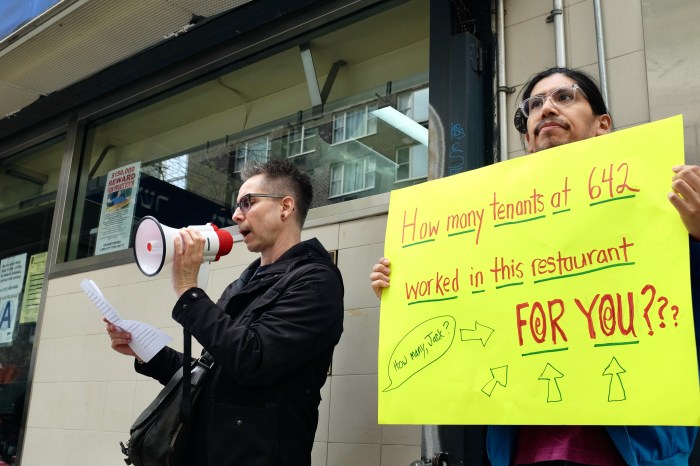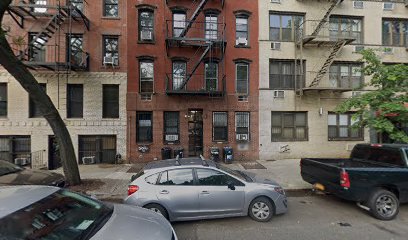By Rebecca Sun, Neil Parmar, Erin Walsh and Albert Amateau
Volume 73, Number 24 | October 15 – 21, 2003
N.Y.U. reacts to second Bobst leap within a month
The suicides of two students in less than four weeks have brought New York University to national attention and have forced the school’s administration to address its treatment of suicide, both preventively and in the aftermath.
Freshman Stephen Bohler jumped to his death from the 10th floor of N.Y.U.’s Bobst Library on Oct. 10, police said. The incident occurred exactly four Fridays after John Skolnik, a 20-year-old junior, leaped from the library’s 10th floor.
Bohler, 18, a resident of Irvine, Calif., who grew up in Dayton, Ohio, gave no sign to fellow students that he was contemplating suicide, according to reports.
While the university dealt with Skolnik’s Sept. 12 death quietly, setting up emergency counseling sessions for students and staff, Bohler’s death brings the two cases to a much higher level of scrutiny. Over the weekend, the national media Web site, Drudge Report, posted a link to N.Y.U.’s daily student newspaper, consequently flooding its server.
On-campus reaction to Friday’s death was also much stronger compared to last month. Todd Allen, a 31-year-old graduate student, was at the library during both suicides. He criticized N.Y.U. officials for the lack of coverage of Skolnik’s death.
“There wasn’t any mention [of his death] in classes and there weren’t any notices sent out to students. There wasn’t even a candlelight vigil,” said Allen. “I understand it’s a new phenomenon, but it’s happened twice now. One more time and it’s a fad.”
On Friday evening, N.Y.U. administration sent an e-mail informing the university community of Bohler’s suicide and offered emergency counseling services to those in need.
“There is a support system to help students ’round the clock at N.Y.U.… Don’t ever feel reluctant to use them if you need them, or to urge a friend to make use of them,” wrote Marc Wais, vice president for student affairs.
The e-mail made no mention of Skolnik’s death, and no similar statement was released after the incident a month ago.
Counselors from the University Counseling Service were on call over the weekend at both Bobst Library and Rubin Residence Hall, 35 Fifth Ave., where Bohler lived. Professors from N.Y.U.’s Ehrenkranz School of Social Work also volunteered their time to counsel librarians, staff members and students.
Consuelo Martagh, a senior counselor with the Faculty and Staff Assistance Program, expressed concern over the two suicides that occurred within such a short period of time. She acknowledged the difficulty of catching warning signs before suicides occur and added, “It’s the nature of the act that leaves you wanting for answers.”
Martagh offered that men tend to end their lives more violently than women, while F.S.A.P. Director Claire Fleming discussed the act of committing suicide in a public place.
“It’s almost as if someone is inviting you to their suicide,” she said.
“As a young person now, this is a very impressionable time in their lives,” Fleming added. “Some people don’t develop the mechanisms to survive. In college, you’re just a little more vulnerable because you’re still negotiating a sense of self.”
Bohler’s death has already created tangible responses by the university. Its e-mail statement read, “The university is implementing a number of measures we deem prudent in response to this tragic episode to increase everyone’s safety.”
The Washington Square News, N.Y.U.’s student newspaper, reported that the administration had erected temporary barriers on the library’s upper balconies.
Security guards were stationed at some balcony points over the weekend, and John Beckman, spokesperson for the university, said tall glass barriers would be installed within the next few weeks on the upper walkways. “The university will be taking measures that it feels are prudent and appropriate,” Beckman said.
Abby Aronofosky, W.S.N.’s managing editor, said her understanding was that barriers would be installed from the third floor up and that they would be floor to ceiling. Beckman said he couldn’t say if the barriers will be floor to ceiling.
According to the university, last month’s suicide plunge was the first in Bobst’s 30-year history.
The building, designed by Philip Johnson and Richard Foster, was completed in 1973 on the southeast corner of Washington Sq. Park. It holds 3.3 million volumes, draws more than 6,000 people on an average school day and its large atrium is often used for university convocations.
Reader Services

















